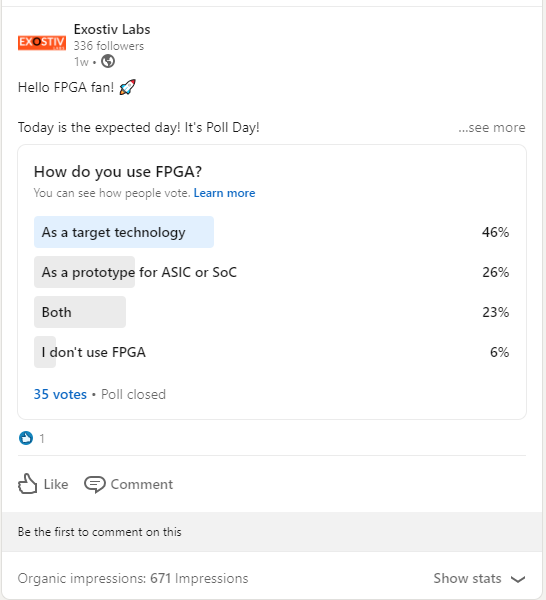
ASIC designers and FPGA OEMs.
Last week, we conducted a quick poll on LinkedIn – about what our followers and readers made of FPGA… See the results below:
So, 24 of the respondents use FPGA as a target technology ((46% + 23%) x 35) – and 17 of them ((26% + 23%) x 35) use FPGA to prototype ASIC.
In terms of usage, with an understanding that there can be an overlap:
– 68% of the respondents use FPGA as a target technology and:
– 48% of the respondents use FPGA as a prototyping technology for ASIC.
Ok, ok. 35 votes is probably not representative enough to allow us to draw conclusions. Anyway, I wanted to compare this result with what we know from our users.
So, I checked the stats I have about our clients, and what they do with FPGA. See below.
– 64% of our clients over the past 5 years use FPGA as a target technology
– 36% of our clients use FPGA as a prototyping technology for ASIC.
Please note, I haven’t been able to check about the overlap. So, we seem to find some similarities…
Hold on, hold on. Isn’t it normal that our client base is statistically the same as who we talk to on LinkedIn? Well, it might explain it for some part of it…
However, we don’t find our clients on LinkedIn only, the respondents to the poll were not all clients, and the reach we usually have with LinkedIn goes beyond our own network.
The fact is that Exostiv Labs is an EDA company that serves both FPGA OEMs (that is the ones using FPGA as a target technology) AND ASIC designers (that is, the onese using FPGA as a prototyping technology).
Our solutions provide value to these 2 types of engineering – at the same time very close to each other, and also very different by the magnitude of their respective budgets, the nature of their projects, the timing thereof and their market dynamics.
In our industry, it is often (too quickly?) said that ‘ASIC designs have budgets and invest in EDA tools, while FPGA OEMs don’t have money and only use free or the vendor tools’…. We actually have a different experience with our clients, and usually find that they invest when the tool brings back value. It might about time to shake up some clichés.
Solving ‘the visibility into FPGA problem’ for ASIC designers AND FPGA OEMs is certainly something that makes us proud as an EDA company.
As always, thank you for reading.
– Frederic


